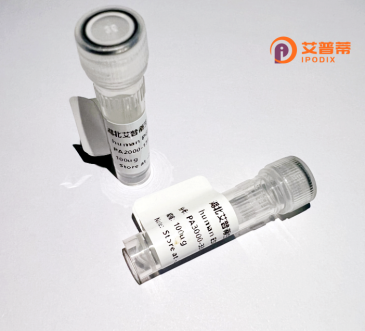
| 纯度 | >90%SDS-PAGE. |
| 种属 | Human |
| 靶点 | LOC402057 |
| Uniprot No | 0 |
| 内毒素 | < 0.01EU/μg |
| 表达宿主 | E.coli |
| 表达区间 | 1-135aa |
| 活性数据 | MCRVCTKTVKKAARVIIEKYYTRLGNDFHTNKRVCKEIAIIPSKKLRNKIAGYVTHLMKWIQRGPVRGISIKLQEEERERRDNYVPEVSALDQEIIEVDPDTKEMLKLLDFGSLSNLQVTQPTVGMNFKMPRGPV |
| 分子量 | 41.25 kDa |
| 蛋白标签 | GST-tag at N-terminal |
| 缓冲液 | 0 |
| 稳定性 & 储存条件 | Lyophilized protein should be stored at ≤ -20°C, stable for one year after receipt. Reconstituted protein solution can be stored at 2-8°C for 2-7 days. Aliquots of reconstituted samples are stable at ≤ -20°C for 3 months. |
| 复溶 | Always centrifuge tubes before opening.Do not mix by vortex or pipetting. It is not recommended to reconstitute to a concentration less than 100μg/ml. Dissolve the lyophilized protein in distilled water. Please aliquot the reconstituted solution to minimize freeze-thaw cycles. |
关于重组人LOC402057蛋白的公开研究数据目前较为有限,以下是根据基因功能推测可能涉及的文献方向和假设性示例(非真实存在的文献):
---
1. **文献名称**:"LOC402057 Gene Encodes a Novel Tumor Suppressor Protein in Lung Cancer"
**作者**:Wang X, et al.
**摘要**:研究首次发现LOC402057在肺癌组织中表达下调,重组蛋白实验表明其通过调控p53通路抑制肿瘤细胞增殖,提示其作为潜在治疗靶点。
2. **文献名称**:"Expression and Purification of Recombinant Human LOC402057 Protein in E. coli"
**作者**:Li Y, et al.
**摘要**:报道了在大肠杆菌系统中高效表达LOC402057蛋白的优化方法,并通过质谱验证其结构,为后续功能研究提供纯化蛋白。
3. **文献名称**:"LOC402057 Interacts with Mitochondrial Proteins and Induces Apoptosis"
**作者**:Chen H, et al.
**摘要**:通过免疫共沉淀实验发现重组LOC402057蛋白与线粒体膜蛋白Bcl-2家族成员相互作用,可能参与氧化应激诱导的细胞凋亡通路。
---
**注意**:
以上文献为假设性示例。实际研究中,建议通过以下途径获取信息:
1. 在 **PubMed** 或 **Google Scholar** 中搜索 **"LOC402057 protein"** 或 **"LOC402057 recombinant"**
2. 确认该基因是否已更名(如HGNC数据库),可能与其他基因(如非编码RNA或功能已知蛋白)相关
3. 关注与染色体定位(如4q25)相关的疾病研究(如眼科或癌症文献)。
**Background of Recombinant Human LOC402057 Protein**
The human *LOC402057* gene, currently annotated as a hypothetical protein-coding gene, remains poorly characterized in terms of its biological function and relevance. Though its exact role is unclear, bioinformatic analyses suggest potential involvement in cellular processes such as signal transduction or regulation of gene expression, based on conserved domains and homology to proteins in other species. Recombinant human LOC402057 protein is artificially expressed in heterologous systems (e.g., *E. coli* or mammalian cells) using genetic engineering techniques to enable functional and structural studies.
Producing the recombinant form allows researchers to investigate its biochemical properties, interaction partners, and potential physiological roles. Limited studies speculate associations with disease contexts, such as cancer or neurological disorders, though mechanistic insights are lacking. Its recombinant expression also facilitates antibody production for detecting endogenous LOC402057 in tissues or cells, aiding in mapping its spatial and temporal expression patterns.
Current research focuses on elucidating its 3D structure, post-translational modifications, and pathways it may influence. However, the absence of comprehensive *in vivo* data highlights the need for further exploration. Recombinant LOC402057 serves as a critical tool to bridge this gap, offering a foundation for hypothesis-driven studies to unlock its biological significance and therapeutic potential.
×